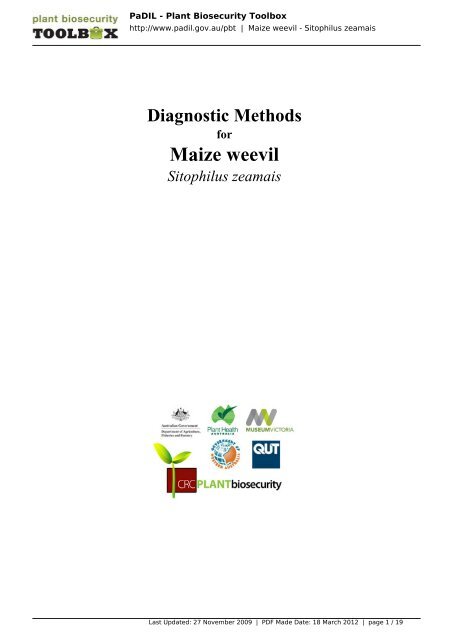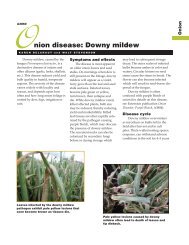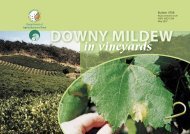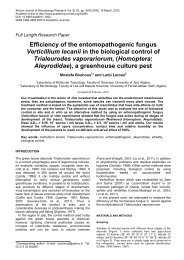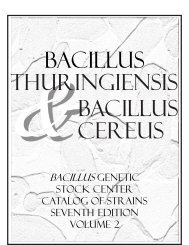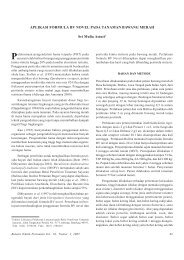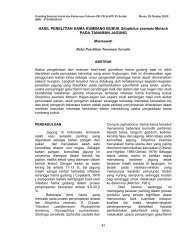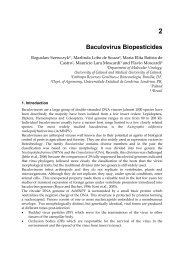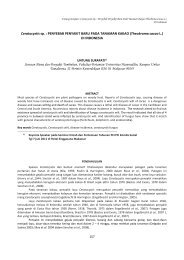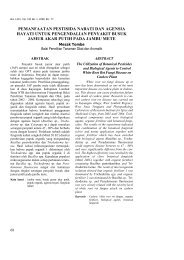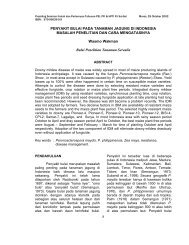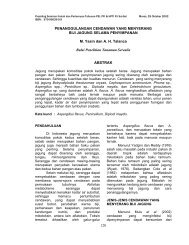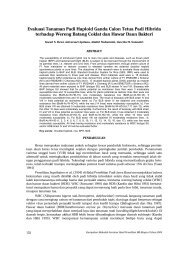Maize weevil - Sitophilus zeamais
Maize weevil - Sitophilus zeamais
Maize weevil - Sitophilus zeamais
Create successful ePaper yourself
Turn your PDF publications into a flip-book with our unique Google optimized e-Paper software.
PaDIL - Plant Biosecurity Toolboxhttp://www.padil.gov.au/pbt | <strong>Maize</strong> <strong>weevil</strong> - <strong>Sitophilus</strong> <strong>zeamais</strong>BiologyStages of DevelopmentDescription of life stagesComplete development time for the life cycle of S. <strong>zeamais</strong> averaged 36 days (range 33-45) at 27 ± 1oC,and 69 ± 3% RH. (Sharifi & Mills, 1971). This development time is almost identical to that for S. oryzaeand is about 7 days faster than S. granarius under similar conditions. Most eggs were deposited in theendosperm, but 28% were in or around the germ.Maximum daily rate of fecundity (6.7 eggs per female in 24 hours), duration of development, and numberof progeny produced were optimal at 30 o C and 75% RH (Throne 1994). The duration of immaturedevelopment of rice <strong>weevil</strong>s is longer when multiple eggs are deposited in a kernel and when more thanon <strong>weevil</strong> larva occurs in a wheat kernel, the larger one will eat the smaller one (Throne 1994).The lower limit for development from egg to adult <strong>weevil</strong>s was 15.6 o C and the upper limit was 32.5 o C at75% RH (Throne 1994).Detail on lifecycleThe female drills a hole into the kernel, deposits the egg, and then secretes a mucilaginous plug to enclosethe egg as the ovipositor is withdrawn. The plug rapidly hardens, leaving a small raised area above theseed surface, which provides the only external evidence that the kernel is infested. Eggs may be laidanywhere in the kernel, but few are laid in the embryo. In wheat, most eggs are deposited at the endfarthest from the embryo. Sometimes, more than one egg may be laid in a single grain but it is rare formore than one larva to develop to maturity, because of cannibalism (Longstaff 1981,).Not all excavated holes are used for oviposition; some are abandoned and others are expanded intofeeding holes (Campbell 2002).Last Updated: 27 November 2009 | PDF Made Date: 18 March 2012 | page 3 / 19
PaDIL - Plant Biosecurity Toolboxhttp://www.padil.gov.au/pbt | <strong>Maize</strong> <strong>weevil</strong> - <strong>Sitophilus</strong> <strong>zeamais</strong>There are four larval instars all of which remain within the grain. Immediately on hatching, the first instarfeeds by burrowing through the tissues of the grain. At the end of the fourth instar the larva uses amixture of frass and larval secretion to close off the end of the burrow, to form a pupal cell. Under normaldevelopmental conditions, <strong>weevil</strong> larvae allow their frass to accumulate around them inside the grain inwhich they are feeding. However, if the carbon dioxide level exceeds 5%, the fourth instar larva makes asmall hole in the grain and ejects much of the frass. The larva then assumes a prepupal form for a shortperiod before transforming into the pupa (Longstaff 1981).When the adult has developed, it remains inside the grain for several days before emerging, with the timevarying with temperature (Longstaff 1981). During this time, it's cuticle hardens and matures.Adults emerge and females move to a surface above the food to release sex pheromone. Males areattracted to this pheromone for mating (Mason 2003).Host RangeS. <strong>zeamais</strong> is commonly associated with corn and rice in tropical storage and to a lesser extent in otherraw or processed cereals, including wheat, oats, barley, sorghum, rye and buckwheat (Figs. 1, 2, 3, 4).The range of moisture contents within which it will breed has been found to be much wider than that of S.oryzae and it has been found to attack fruit, such as apples, in storage. S. <strong>zeamais</strong> commonly infestsstanding crops prior to harvest, particularly maize, where the moisture contents can exceed 20% (Anon.2009b, Longstaff 1981, Maceljski & Korunic 1973).DistributionS. <strong>zeamais</strong> occurs throughout the warmer, more humid regions of the world, especially where maize isgrown (Longstaff 1981). It has also been recorded from Canada (Anon. 2009b).Polynesia (Zimmerman 1968), Argentina, Brazil, Burma, Cambodia, Greece, Japan, Morocco, Spain,Syria, Turkey, USA, USSR, Yugoslavia (Maceljski & Korunic 1973).S. <strong>zeamais</strong> is widely distributed throughout growing areas of northern Australia.Last Updated: 27 November 2009 | PDF Made Date: 18 March 2012 | page 4 / 19
PaDIL - Plant Biosecurity Toolboxhttp://www.padil.gov.au/pbt | <strong>Maize</strong> <strong>weevil</strong> - <strong>Sitophilus</strong> <strong>zeamais</strong>DetectionDetection MethodBalasubramanian, A., Jayas, D.S., Fernando, W.G.D., Li, G., White, N.D.G. 2007. Sensitivity analysis ofDNA fingerprinting technique for detecting insect fragments in wheat flour. Canadian BiosystemsEngineering, 49: 41-45.http://www.bashanfoundation.org/dilantha/dilanfingerprinting.pdfBrader, B., Lee, R.C., Plarre, R., Burkholder, W. et al. 2002. A comparison of screening methods forinsect contamination in wheat. Journal of Stored Products Research, 38: 75-86.http://www.sciencedirect.com/science?_ob=ArticleURL&_udi=B6T8Y-43YY60T-9&_user=139754&_rdoc=1&_fmt=&_orig=search&_sort=d&view=c&_acct=C000011578&_version=1&_urlVersion=0&_userid=139754&md5=6f080a6a1f8b79906d6c1e754bbe0ef2Neethirajan, S., Karunakaran, C., Jayas, D.S., White, N.D.G. 2007. Detection techniques forstored-product insects in grain. Food Control, 18:157-162.http://www.sciencedirect.com/science?_ob=ArticleURL&_udi=B6T6S-4HH81D9-2&_user=139754&_rdoc=1&_fmt=&_orig=search&_sort=d&view=c&_acct=C000011578&_version=1&_urlVersion=0&_userid=139754&md5=7c69d2a0a876fc1ad83c2dc0b6308cb5Peng, W.K., Lin, H.C., Wang, C.H. 2003. DNA identification of two laboratory colonies of the <strong>weevil</strong>s,<strong>Sitophilus</strong> oryzae (L.) and S. <strong>zeamais</strong> Motschulsky (Coleoptera: Curculionidae) in Taiwan. Journal ofStored Products Research, 39(2): 225-235.http://www.sciencedirect.com/science?_ob=ArticleURL&_udi=B6T8Y-44VG0JR-5&_user=139754&_rdoc=1&_fmt=&_orig=search&_sort=d&view=c&_acct=C000011578&_version=1&_urlVersion=0&_userid=139754&md5=19583ed7063b3ca07b1245d47cb9b48cLast Updated: 27 November 2009 | PDF Made Date: 18 March 2012 | page 5 / 19
PaDIL - Plant Biosecurity Toolboxhttp://www.padil.gov.au/pbt | <strong>Maize</strong> <strong>weevil</strong> - <strong>Sitophilus</strong> <strong>zeamais</strong>Rajendran, S. 2005. Detection of insect infestation in stored foods. Advances in Food and NutritionResearch, 49: 163-232.Symptom DescriptionS. <strong>zeamais</strong> feed on individual grains, leaving only the hulls, and a severe infestation can reduce storedgrain to a mass of hulls and flour-like, powdery frass. Infested grains exhibit holes where adults haveemerged. Grain which floats on the surface of water often indicates larval damage inside the kernel.Infested grain will usually be found heating at the surface, and it may be damp, sometimes to such anextent that sprouting occurs.The egg, larvae and pupae stages occur inside the grain, and they are rarely seen outside of the grain. Thelarval stages feed on the internal portions of whole grains, making early detection of infestations difficult.This not only reduces the quality of the grain but also produces large amounts of heat and grain dust andfrass (Longstaff 1981, Lyon, undated).Symptom ImagesFigure 1. Adult <strong>Sitophilus</strong> <strong>zeamais</strong> on maize grain. Image: United States Department of Agriculture,Agricultural Research Service. http://www.ars.usda.gov/is/graphics/photos/aug00/k8854-1i.jpgLast Updated: 27 November 2009 | PDF Made Date: 18 March 2012 | page 6 / 19
PaDIL - Plant Biosecurity Toolboxhttp://www.padil.gov.au/pbt | <strong>Maize</strong> <strong>weevil</strong> - <strong>Sitophilus</strong> <strong>zeamais</strong>Figure 2. Newly emerged <strong>Sitophilus</strong> <strong>zeamais</strong> adults on maize seed, showing emergence holes. Image:Canadian Grain Commission. http://www.grainscanada.gc.ca/storage-entrepose/pip-irp/mw-cr-eng.htmLast Updated: 27 November 2009 | PDF Made Date: 18 March 2012 | page 7 / 19
PaDIL - Plant Biosecurity Toolboxhttp://www.padil.gov.au/pbt | <strong>Maize</strong> <strong>weevil</strong> - <strong>Sitophilus</strong> <strong>zeamais</strong>Figure 3. <strong>Sitophilus</strong> <strong>zeamais</strong> infesting maize cobs. Image: University of Georgia Archive, University ofGeorgia, Bugwood.org http://www.forestryimages.org/browse/detail.cfm?imgnum=1673036Figure 4. <strong>Maize</strong> cobs infested with <strong>Sitophilus</strong> <strong>zeamais</strong>. Image: Frank Peairs, Colorado State University,United States http://www.forestryimages.org/browse/detail.cfm?imgnum=1481061Sites of Infection/InfestationCommonly associated with corn and rice in warm humid areas, and also in tropical standing crops (Figs.1, 2, 3, 4). It has been found to attack fruit, such as apples, in storage. S. <strong>zeamais</strong> is a major pest of storedrice, but is of less importance in wheat. They cannot breed in finely processed grain but will readily breedin manufactured flour products such as macaroni and noodles, and also in milled cereals that have becomecaked from excess moisture.Last Updated: 27 November 2009 | PDF Made Date: 18 March 2012 | page 8 / 19
PaDIL - Plant Biosecurity Toolboxhttp://www.padil.gov.au/pbt | <strong>Maize</strong> <strong>weevil</strong> - <strong>Sitophilus</strong> <strong>zeamais</strong>IdentificationMorphological MethodsEgg: no useful info yetLarvae: Soft, white and legless.Pupae: Naked and white.Figure 5. <strong>Sitophilus</strong> spp. pupa developing inside grain. Image: US Department of Agriculture,Agricultural Research Services.Last Updated: 27 November 2009 | PDF Made Date: 18 March 2012 | page 9 / 19
PaDIL - Plant Biosecurity Toolboxhttp://www.padil.gov.au/pbt | <strong>Maize</strong> <strong>weevil</strong> - <strong>Sitophilus</strong> <strong>zeamais</strong>Adult: Adults reach a length of 3 - 3.5 mm long. They are very similar in appearance to the rice <strong>weevil</strong>except longer. The reddish markings on the elytra are more clearly defined, being light red to yellow incolour. Body colour varies from dull red-brown to almost black. S. <strong>zeamais</strong> has fully developed wingsbeneath the elytra and flies readily.The thorax is densely pitted with irregularly shaped punctures, except for the smooth narrow stripextending down the midline of the dorsal side.Figure 6. Adult <strong>Sitophilus</strong> oryzae - dorsal view. S. <strong>zeamais</strong> is superficially similar and would requiredissection and examination of the male genitalia for a positive identification. Image: Gary Alpert,Harvard University, United States. http://www.forestryimages.org/browse/detail.cfm?imgnum=5380353To sex adult <strong>Sitophilus</strong>:Females: Rostrum relatively long and narrow, punctures along rostrum in regular rows and not touchingeach other.Last Updated: 27 November 2009 | PDF Made Date: 18 March 2012 | page 10 / 19
PaDIL - Plant Biosecurity Toolboxhttp://www.padil.gov.au/pbt | <strong>Maize</strong> <strong>weevil</strong> - <strong>Sitophilus</strong> <strong>zeamais</strong>Leelaja, B.C., Rajashekar, Y., Rajendran, S. 2007. Detection of eggs of stored-product insects in flourwith staining techniques. Journal of Stored Products Research, 43: 206-210.Last Updated: 27 November 2009 | PDF Made Date: 18 March 2012 | page 12 / 19
PaDIL - Plant Biosecurity Toolboxhttp://www.padil.gov.au/pbt | <strong>Maize</strong> <strong>weevil</strong> - <strong>Sitophilus</strong> <strong>zeamais</strong>Further InformationContactsDr Greg Daglish, Principal Entomologist - Queensland Primary Industry and Fisheries.Ph. 07 3896 9415Email Greg.Daglish@deedi.qld.gov.auAndrew Ridley, Research Scientist - Queensland Primary Industries and Fisheries.Ph. 07 3896 9680Email Andrew.ridley@deedi.qld.gov.auAcknowledgementsProtocol author: Julianne Farrell, julianne.farrell@dpi.qld.gov.auProtocol has been reviewed by Dr Barry Wallbank.Last Updated: 27 November 2009 | PDF Made Date: 18 March 2012 | page 13 / 19
PaDIL - Plant Biosecurity Toolboxhttp://www.padil.gov.au/pbt | <strong>Maize</strong> <strong>weevil</strong> - <strong>Sitophilus</strong> <strong>zeamais</strong>ReferencesAnderson, D.M. 1987. Larval beetles (Coleoptera). In: Insect and Mite Pests in Food: An illustrated key.(Ed. J.R. Gorham). USDA Handbook No. 655, United States Department of Agriculture: Washington DC,USA. Vol 1, pp 95-114.http://www.afpmb.org/pubs/tims/tg27/docs/Insect%20and%20Mite%20Pests%20in%20Food%20Gorham.pdfAnonymous. 2008a. Granary <strong>weevil</strong> <strong>Sitophilus</strong> granarius (L.) Canadian Grain Commission.http://www.grainscanada.gc.ca/storage-entrepose/pip-irp/gw-cg-eng.htmAnonymous. 2009. Rice <strong>weevil</strong> <strong>Sitophilus</strong> oryzae (L.) Canadian Grain Commission.http://www.grainscanada.gc.ca/storage-entrepose/pip-irp/rw-cr-eng.htmAnonymous. 2009b. <strong>Maize</strong> <strong>weevil</strong> <strong>Sitophilus</strong> <strong>zeamais</strong> (Motsch.) Canadian Grain Commission.http://www.grainscanada.gc.ca/storage-entrepose/pip-irp/mw-cr-eng.htmBalasubramanian, A., Jayas, D.S., Fernando, W.G.D., Li, G., White, N.D.G. 2007. Sensitivity analysis ofDNA fingerprinting technique for detecting insect fragments in wheat flour. Canadian BiosystemsEngineering, 49: 41-45.http://www.bashanfoundation.org/dilantha/dilanfingerprinting.pdfLast Updated: 27 November 2009 | PDF Made Date: 18 March 2012 | page 14 / 19
PaDIL - Plant Biosecurity Toolboxhttp://www.padil.gov.au/pbt | <strong>Maize</strong> <strong>weevil</strong> - <strong>Sitophilus</strong> <strong>zeamais</strong>Bousquet, Y. 1990. Beetles associated with stored products in Canada: An identification guide.Agriculture and Agri-Food Canada.http://home.cc.umanitoba.ca/~fieldspg/fields/beetles.pdfBrader, B., Lee, R.C., Plarre, R., Burkholder, W. et al. 2002. A comparison of screening methods forinsect contamination in wheat. Journal of Stored Products Research, 38: 75-86.http://www.sciencedirect.com/science?_ob=ArticleURL&_udi=B6T8Y-43YY60T-9&_user=139754&_rdoc=1&_fmt=&_orig=search&_sort=d&view=c&_acct=C000011578&_version=1&_urlVersion=0&_userid=139754&md5=6f080a6a1f8b79906d6c1e754bbe0ef2Boudreaux, H.B. 1969. The identity of <strong>Sitophilus</strong> oryzae. Annals of the Entomological Society of America, 62(1): 169-172.Campbell, J.F. 2002. Influence of seed size on exploitation by the rice <strong>weevil</strong>, <strong>Sitophilus</strong> oryzae. Journalof Insect Behaviour, 15(3): 420-445.Danho, M., Gaspar, C., Haubruge, E. 2002. The impact of grain quantity on the biology of <strong>Sitophilus</strong><strong>zeamais</strong> Motschulsky (Coleoptera: Curculionidae): oviposition, distribution of eggs, adult emergence,body weight and sex ratio. Journal of Stored Products Research, 38(3): 259-266.http://www.sciencedirect.com/science?_ob=ArticleURL&_udi=B6T8Y-451WGP3-6&_user=139754&_rdoc=1&_fmt=&_orig=search&_sort=d&view=c&_acct=C000011578&_version=1&_urlVersion=0&_userid=139754&md5=00b645d49d1829d5601600aeb8f5ead9http://www.fsagx.ac.be/zg/Publications/pdf%20zoologie/1301-1350/1326.pdfLast Updated: 27 November 2009 | PDF Made Date: 18 March 2012 | page 15 / 19
PaDIL - Plant Biosecurity Toolboxhttp://www.padil.gov.au/pbt | <strong>Maize</strong> <strong>weevil</strong> - <strong>Sitophilus</strong> <strong>zeamais</strong>Floyd, E.H., Newsom, L.D. 1959. Biological study of the rice <strong>weevil</strong> complex. Annals of theEntomological Society of America, 52(6): 687-695.Halstead, D.G.H. 1963. External sex differences in stored products Coleoptera. Bulletin of EntomologicalResearch, 54: 119-134.Kingsolver, J.M. 1987. Adult beetles (Coleoptera). In: Insect and Mite Pests in Food: An illustrated key.(Ed. J.R. Gorham). USDA Handbook No. 655, United States Department of Agriculture: Washington DC,USA. Vol 1, pp 75-94.http://www.afpmb.org/pubs/tims/tg27/docs/Insect%20and%20Mite%20Pests%20in%20Food%20Gorham.pdfKiritani, K. 1965. Biological studies on the <strong>Sitophilus</strong> complex (Coleoptera: Curculionidae) in Japan.Journal of Stored Products Research, 1: 169-176.LeCato, G.L., Flaherty, B.R. 1974. Description of eggs of selected species of stored-product insects(Coleoptera and Lepidoptera). Journal of the Kansas Entomological Society, 47(3): 308-317.http://www.jstor.org/stable/pdfplus/25082655.pdfLongstaff, B.C. 1981. Biology of the grain pest species of the genus <strong>Sitophilus</strong> (Coleoptera:Curculionidae): A critical review. Protection Ecology, 2: 83-130.Lyon, W.F. Granary and Rice Weevils. Undated. HYG-2088-97. Ohio State University Extension FactSheet.http://ohioline.osu.edu//hyg-fact/2000/2088.htmlLast Updated: 27 November 2009 | PDF Made Date: 18 March 2012 | page 16 / 19
PaDIL - Plant Biosecurity Toolboxhttp://www.padil.gov.au/pbt | <strong>Maize</strong> <strong>weevil</strong> - <strong>Sitophilus</strong> <strong>zeamais</strong>http://www.google.com/gwt/n?u=http%3A%2F%2Fohioline.osu.edu%2Fhyg-fact%2F2000%2F2088.htmlLeelaja, B.C., Rajashekar, Y., Rajendran, S. 2007. Detection of eggs of stored-product insects in flourwith staining techniques. Journal of Stored Products Research, 43: 206-210.Maceljski, M., Korunic, Z. 1973. Contribution to the morphology and ecology of <strong>Sitophilus</strong> <strong>zeamais</strong>Motsch. in Yugolsavia. Journal of Stored Products Research, 9: 225-234.Mason, L.J. (2003). Grain Insect Fact Sheet, E-237-W: Rice, Granary, and <strong>Maize</strong> Weevils <strong>Sitophilus</strong>oryzae (L.), S. granarius (L.), and S. <strong>zeamais</strong> (Motsch). Purdue University,Department of Entomology.http://extension.entm.purdue.edu/publications/E-237.pdfMeagher, R.L., Reed, C., Mills, R.B. 1982. Development of <strong>Sitophilus</strong> <strong>zeamais</strong> and Tribolium castaneumin whole, cracked, and ground pearl millet. Journal of the Kansas Entomological Society, 55(1): 91-94.http://www.jstor.org/stable/pdfplus/25084262.pdfMeikle, W.G., Holst, N., Markham, R.H. 1999. Population simulation model of <strong>Sitophilus</strong> <strong>zeamais</strong>(Coleoptera: Curculionidae) in grains stores in West Africa. Environmental Entomology, 28(5): 836-844.Nardon, C, Nardon, P. 2002. New characters to distinguish larvae and adults of the two sibling species:<strong>Sitophilus</strong> oryzae(L.) and S. <strong>zeamais</strong> Mots. (Coleoptera, Dryophthoridae). Annales de la SocieteLast Updated: 27 November 2009 | PDF Made Date: 18 March 2012 | page 17 / 19
PaDIL - Plant Biosecurity Toolboxhttp://www.padil.gov.au/pbt | <strong>Maize</strong> <strong>weevil</strong> - <strong>Sitophilus</strong> <strong>zeamais</strong>Entomologique de France, 38(3): 239-246.Neethirajan, S., Karunakaran, C., Jayas, D.S., White, N.D.G. (2007). Detection techniques forstored-product insects in grain. Food Control, 18:157-162.http://www.sciencedirect.com/science?_ob=ArticleURL&_udi=B6T6S-4HH81D9-2&_user=139754&_rdoc=1&_fmt=&_orig=search&_sort=d&view=c&_acct=C000011578&_version=1&_urlVersion=0&_userid=139754&md5=7c69d2a0a876fc1ad83c2dc0b6308cb5Peng, W.K., Lin, H.C., Wang, C.H. 2003. DNA identification of two laboratory colonies of the <strong>weevil</strong>s,<strong>Sitophilus</strong> oryzae (L.) and S. <strong>zeamais</strong> Motschulsky (Coleoptera: Curculionidae) in Taiwan. Journal ofStored Products Research, 39(2): 225-235.http://www.sciencedirect.com/science?_ob=ArticleURL&_udi=B6T8Y-44VG0JR-5&_user=139754&_rdoc=1&_fmt=&_orig=search&_sort=d&view=c&_acct=C000011578&_version=1&_urlVersion=0&_userid=139754&md5=19583ed7063b3ca07b1245d47cb9b48cProctor, D.L. 1971. An additional aedeagal character for distinguishing <strong>Sitophilus</strong> <strong>zeamais</strong> Motsch. from<strong>Sitophilus</strong> oryzae (L.) (Coleoptera: Cuculionidae). Journal of Stored Products Research, 6: 351-352.Rajendran, S. 2005. Detection of insect infestation in stored foods. Advances in Food and NutritionResearch, 49: 163-232.Rees, D. Pest trends in the Australian grain bulk handling system. Proceedings of the AustralianPostharvest Technical Conference 1998, pp 39-42.http://sgrl.csiro.au/aptc1998/09_rees.pdfRees, D. (2004). Insects of Stored Products. CSIRO Publishing, Collingwood, Australia.Last Updated: 27 November 2009 | PDF Made Date: 18 March 2012 | page 18 / 19
PaDIL - Plant Biosecurity Toolboxhttp://www.padil.gov.au/pbt | <strong>Maize</strong> <strong>weevil</strong> - <strong>Sitophilus</strong> <strong>zeamais</strong>Rotondo, G., Germinara, G.S., De Cristofaro, A. 2000. Immuno-osmophoretic technique for detecting<strong>Sitophilus</strong> granarius (L.) infestations in wheat. Journal of Stored Products Research, 36(2): 153-160.http://www.sciencedirect.com/science?_ob=ArticleURL&_udi=B6T8Y-3YJYDG5-6&_user=139754&_rdoc=1&_fmt=&_orig=search&_sort=d&view=c&_acct=C000011578&_version=1&_urlVersion=0&_userid=139754&md5=e0c2970a4756f72b4445ef5f1608e71aSharifi, S., Mills, R.B. 1971. Radiographic studies of <strong>Sitophilus</strong> <strong>zeamais</strong> Mots. In wheat kernels. Journalof Stored Products Research, 7: 195-206.Throne, J.E. 1994. Life history of immature maize <strong>weevil</strong>s (Coleoptera:Curculionidae) on corn stored atconstant temperatures and relative humidities in the laboratory. Environmental Entomology, 23(6):1459-1471.Tolpo, N.C., Morrison, E.O. 1965. Sex determination by snout characteristics of <strong>Sitophilus</strong> <strong>zeamais</strong>Motschulsky. Texas Journal of Science, 17(1): 122-122.Walker, K. 2008b. Rice <strong>weevil</strong> (<strong>Sitophilus</strong> oryzae). Pest and Diseases Image Library.http://www.padil.gov.au/viewPestDiagnosticImages.aspx?id=675Zimmerman, E.C. 1968. Rhynchophorinae of Southeastern Polynesia. Pacific Insects, 10(1): 47-77.http://hbs.bishopmuseum.org/pi/pdf/10(1)-47.pdfZimmerman, E.C. 1994. Australian Weevils. Vol. 2. Melbourne: CSIRO Publishing, Australia. 755 pp.Last Updated: 27 November 2009 | PDF Made Date: 18 March 2012 | page 19 / 19


